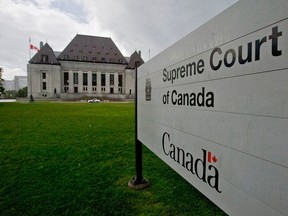Recent cases highlight how difficult it is to determine what is in a child’s best interests when biological ties are at issue

Reviews and recommendations are unbiased and products are independently selected. Postmedia may earn an affiliate commission from purchases made through links on this page.
Article content
As the make up of families changes, the resolution of parenting issues becomes more complex. The laws in each province and the federal laws set out a non-inclusive list of factors for the court to consider when deciding parenting issues. Included in those factors is the relationship between the child and the parent and with other family members. Two recent cases highlight how difficult it is to determine what is in a child’s best interests when biological ties are at issue.
Advertisement 2
Article content
The first case involved J and C , male same-sex partners who had been together for 10 years. They were friends with a woman, B and her new partner, A. As friends, B had discussions with J and C about acting as their surrogate. Both couples were of limited means, and while they tried to deal with the legal aspects of a surrogacy arrangement, no surrogacy agreement was signed. Circumstances changed when B inadvertently became pregnant with A’s child. Even though the initial plan had been that C would provide the sperm, once B became pregnant, plans for the baby did not really change. However, a formal surrogacy arrangement was no longer possible as the law requires that a legally binding agreement be made before pregnancy.
Advertisement 3
Article content
Throughout B’s pregnancy, J and C prepared their home for a newborn, contributed to B’s pre-natal expenses and organized their future work schedules so that between them, they would be full time caregivers for the baby.
B and A did none of these things.
When the baby was a day old, B and A handed her over to J and C in a coffee shop parking lot. But when the baby was four-months old — having not seen her at all since her birth — B and A demanded the baby back.
Article content
Predictably, litigation followed.
At trial, Justice Nathalie Gregson had to decide whether the child should continue to live with J and C; who should make major decisions for the child; and what arrangements, if any, there should be for contact with the non-residential couple. The judge decided that J and C —despite having no biological ties to the baby — should be the child’s primary caregivers and should make all major decisions for the child. Among other reasons, she found that the baby was flourishing in the care of J and C, and that they were also prepared to facilitate B and A’s relationship with the baby.
Advertisement 4
Article content
In a different context, the Supreme Court of Canada also considered the importance of biological ties in B.J.T.v J.D. In B.J.T., the biological mother and father lived in Alberta and had a short but tumultuous marriage. The mother had mental health issues; the father had allegedly been physically violent. The mother returned to P.E.I., without the father knowing about the pregnancy. The mother’s mental health issues worsened after the baby’s birth, and ultimately the baby’s maternal grandmother moved to P.E.I. to help care for the child.
-

Family law faces double-dipping dilemma when it comes to stock options, other deferred compensation
-

Lying low may not be the best course of action when it comes to temporary spousal support claims
-

Suing your ex’s family for conspiracy no longer out of bounds if they help in the evasion of child support
Advertisement 5
Article content
The grandmother cared for the child for over two years. The mother’s mental health declined further and she refused to allow the grandmother to continue to care for the child. Child protection services apprehended the child from the mother, and the grandmother returned to care for the child. Meanwhile, the father, even though he had never met the child, decided that he should bring the child back to Alberta to live with him. After a period of integration between the child and the father, child protection services agreed that the father should have the child. The grandmother disagreed.
The P.E.I. trial judge decided that it was in the child’s best interests for the grandmother to continue to raise the child. The P.E.I. Court of Appeal set aside the trial judge, relying in part on the father’s closer biological ties with the child.
Advertisement 6
Article content
Justice Sheilah Martin of the Supreme Court of Canada, wrote for a unanimous court. In restoring the trial judge’s decision, Justice Martin considered the relevance of a biological tie when determining a child’s best interests. She noted that the institution of the family in Canada has undergone a profound evolution and found that a biological tie is just “one factor among many.”
As both the grandmother and the father had a biological connection to the child, the judge went further, commenting that “a biological tie may be intangible and difficult to articulate; it is difficult to prioritize over other more concrete best interest factors.” The Supreme Court agreed with the trial judge, who had decided that the grandmother was more inclined to facilitate the father’s time with the child than vice versa, and as such, the grandmother should be the child’s primary caregiver.
In B.J.T., Justice Martin recognized the changing nature the Canadian family, observing that children are increasingly being raised in families where biological ties do not define the family relationship. A mere biological connection to a child is no longer a ‘tiebreaker’ when the best interests of a child are involved.
Laurie Pawlitza is a senior partner in the family law group at Torkin Manes LLP in Toronto. lpawlitza@torkinmanes.com

